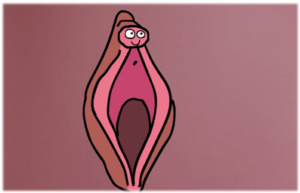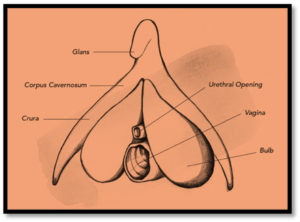By Brianna Green
 In my previous blog, Navigating the Forbidden Fruit, I talked about the external genital area. Remember this area includes the (two) libias, urethra, and the opening of the genitals. However, one of the key parts of this area is the clitoris, which is also known as the erogenous tissue. Remember, this organ sits on top of the external genital area, is roughly the size of a pea, and tends to be sensitive (MedicalNewsToday).
In my previous blog, Navigating the Forbidden Fruit, I talked about the external genital area. Remember this area includes the (two) libias, urethra, and the opening of the genitals. However, one of the key parts of this area is the clitoris, which is also known as the erogenous tissue. Remember, this organ sits on top of the external genital area, is roughly the size of a pea, and tends to be sensitive (MedicalNewsToday).
But don’t be mistaken, this tiny organ is more than what it seems. And, in fact, it’s not actually the size of a pea. It’s actually much bigger than that and the “pea” portion is referred to as the glands clitoris, the only visible part of the organ (MedicalNewsToday). In the diagram, below, it includes the corpus cavernosum, which are sponge-like pair of erectile tissue which contains most of the blood during erogenous tissue erection (Wikipedia). Similarly, you have “the two crura, which extend, like brackets, down from the glans clitoris and deep into the tissue [on either side] of the vulva” (MedicalNewsToday). Finally, you have the two bulbs that are on either side of the external genital opening. The whole structure can be as long as seven centimeters (MedicalNewsToday).
From the research I’ve done, the only function the erogenous tissue seems to have is pleasure. It’s hypothesized that once upon a time a person with this organ might’ve needed to orgasm to reproduce but that is currently not the case. Sadly, there isn’t really that much knowledge about this pleasure treasure chest. Feminine sexuality and pleasure aren’t usually at the forefront of inquiry since muliebrous people have been seen as reproductive machines in the past. However, I don’t agree with that thinking. Pleasure for all kinds of individuals should be looked into, explored, and talked about. So, in another blog, I’m going to continue to break that taboo and talk about another puzzling phenomenon: the organism (which we might be able to thank our friend, the erogenous tissue, for).
upon a time a person with this organ might’ve needed to orgasm to reproduce but that is currently not the case. Sadly, there isn’t really that much knowledge about this pleasure treasure chest. Feminine sexuality and pleasure aren’t usually at the forefront of inquiry since muliebrous people have been seen as reproductive machines in the past. However, I don’t agree with that thinking. Pleasure for all kinds of individuals should be looked into, explored, and talked about. So, in another blog, I’m going to continue to break that taboo and talk about another puzzling phenomenon: the organism (which we might be able to thank our friend, the erogenous tissue, for).
Although I’m talking about the erogenous tissue, keep in mind that not everyone’s anatomy looks this way. If someone is transgender or intersex they might experience or have different anatomical features. For instance, intersex individuals may have ambiguous genitalia which look similar to this but might not include this erogenous tissue; and transgender people who have not had (or don’t want) gender confirmation surgery may refer to their genitals differently. Here (https://www.urologyhealth.org/urology-a-z/a_/ambiguous-(uncertain)-genitalia) is an article from the Urology Care Foundation which further explains intersex. I will also feature this (https://youtu.be/Mb5umSACjcw) video again that shows how transgender and nonbinary individuals can refer to their genitalia if they don’t want to use this terminology.
Resources
“Corpus Cavernosum of Clitoris.” Wikipedia, Wikimedia Foundation, 1 Oct. 2019, en.wikipedia.org/wiki/Corpus_cavernosum_of_clitoris.
“Five Things You Should Know about the Clitoris.” Medical News Today, MediLexicon International, www.medicalnewstoday.com/articles/322235.
Mangaldas, Leeza, director. What Is the Clitoris? | Leeza Mangaldas. YouTube, 4 Feb. 2020, www.youtube.com/watch?v=Q7v7n2H3Nfs&t=183s.